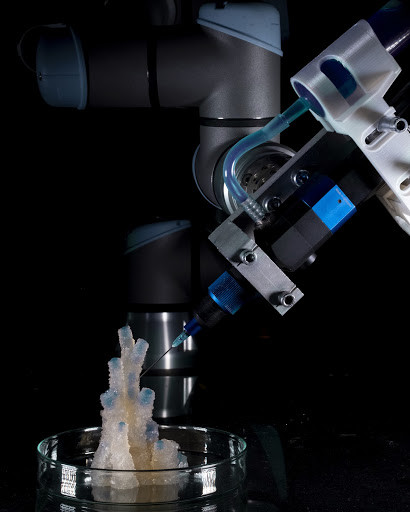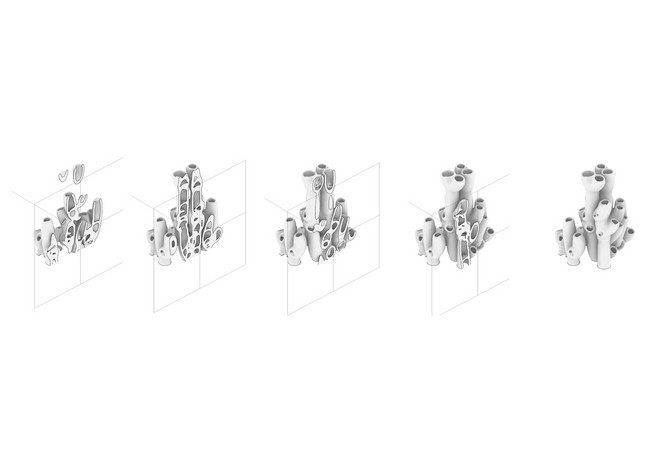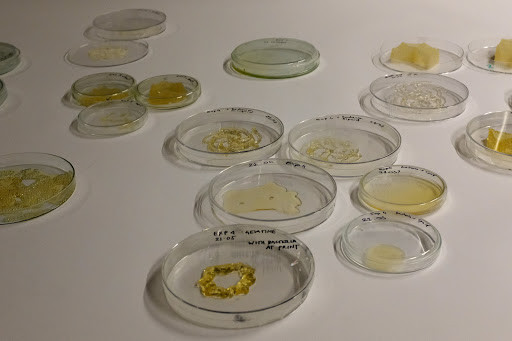
BioLum

BioLum examines the making of a bio-luminescent micro architecture. The project is an interdisciplinary research enquiry sitting at the intersection of architecture, design and microbiology exploring the use of light-emitting bacteria as architectural materiality.
By investigating the 3D printing of bioluminescent bacteria, we are questioning how architecture can be host for an ecology of species in symbiotic coexistence.
BioLum investigate the critical thinking and appropriation of living bacteria as an architectural materiality. To do so, we explore bioluminescence: a chemical form of light produced by many marine organisms, some insects and mushrooms. In ‘BioLum’ we use bioluminescent bacteria to examine the metabolism of a living architecture.
The project is conceived over a series of experiments appropriating techniques for growing luminescent bacteria and developing the technologies for 3D printing the extrusion of their medium. 3D printing is explored as a means of liberating the forming processes of the medium to investigate how topology and surface treatment can drive the life cycles and therefore the light performance of the bacteria. In BioLum we use a collaborative robot with a bespoke micro dispenser. This allows us to address an architectural scale of fabrication distinct from dedicated bioprinter that operate at smaller scales. The building of new 3D printing methods for collaborative robots also allows us to interface with programmable design environments, allowing a higher degree of control and steering of both the design and the environment for the organisms.

The design of the micro architecture probes employs a differential curve growth algorithm. This allows us to maximise the surface to volume ratio of the structure and optimise the bacteria’s light emitting capacity. The line differential growth algorithm also allows us to generate the robot print path as an intrinsic part of the design process allowing greater unity between processes of design and processes of making.
The branching structure generates a complex interior section with distributed hollows that act as vessels for bacterial growth. The complexity of the micro architecture probes allow us to steer the emission of light through topology.

‘BioLum’ sits at the intersection of biodesign and digital fabrication. It opens up new perspectives for the design and appropriation of bioluminescence as an architectural materiality. At a conceptual level, the project asks what happens when the material of architecture becomes living: what are the new concepts, methods and technologies that are needed to design for and with living materials?

References
Mette Ramsgaard Thomsen, Martin Tamke, Aurelie Mosse, Jakob Sieder-Semlitsch, Hanae Bradshaw, Emil Fabritius Buchwald, Maria Mosshammer. (2021). Imprimer La Lumiere - 3d Printing Bioluminescence For Architectural Materiality. Proceedings of CAADRIA 2021, 10.
Publications
Mette Ramsgaard Thomsen, Martin Tamke, Aurelie Mosse, Jakob Sieder-Semlitsch, Hanae Bradshaw, Emil Fabritius Buchwald, Maria Mosshammer. (2021). Imprimer La Lumiere - 3d Printing Bioluminescence For Architectural Materiality. Proceedings of CAADRIA 2021, 10. https://link.springer.com/chapter/10.1007/978-981-16-5983-6_28















